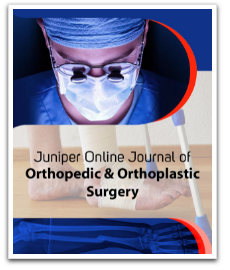Choosing an Imaging Modality for Achilles Tendon: USG Versus MRI- Juniper Publishers
Juniper Online Journal of Orthopedic & Orthoplastic Surgery- Juniper Publishers
Introduction
Ultrasonography and MRI are two advancements in Medical Science being used at an advanced rate in this era. Magnetic Resonance Imaging works by scanning the Patient's Protons as they align along the Magnetic Field created by scanner, the protons in the patient's tissues align themselves along the direction of the magnetic field. A radiofrequency pulse then deflects the protons which as they realign produce a signal which is detected and an image is produced [1]. The principle behind ultrasonography is the Ultrasound waves, which are inaudible high-frequency mechanical vibrations that are formed when a generator produces electrical energy which is converted to acoustic energy through the transducer. The signals are received as they are transmitted back and an Image is formed [2].
The Achilles Tendon is a conjoined tendon of Gastrocnemius and Soleus muscles of the calf and it attaches to calcaneus. The tendon is thickest tendon of the body and is covered by Fascia and is prominent behind the bone; the gap being filled by Adipose tissue and areolar tissue. Just like every other body part, pathologies of Achilles Tendon undergo several tests before being diagnosed. These include palpation, calf squeeze test and Simmonds-Thompson test. But MRI and USG are the more new and advanced methods helping in differentiating normal and abnormal Achilles Tendon [3].
MRI and USG are analogous for detection of full thickness and partial thickness tendon pathologies. In specialized hospital settings, USG is readily available, cost-effective procedure, but gives only minute details about nerve lesions [4]. In a study Ultrasonography detected abnormality in 65% of symptomatic tendons, normal morphology in 68% of asymptomatic tendons while MRI identified abnormal morphology in 56% of symptomatic tendons, normal morphology in 94% of asymptomatic tendons [5]. A case report by Peck & et al significantly emphasized on importance of Ultrasonography as a better tool to be used at emergency ground for diagnosing Achilles tendon rupture [6].
The main advantage of ultrasonography over MRI is its easy availability, repeatability, comparison with contralateral side, low cost and ease of examination with dynamic capability. Infections can be detected with USG, but related bony involvement is difficult to detect and evaluate. MRI offers an advantage of distinguishing bony involvement with high accuracy [7]. A review article on lower extremity injury pattern highlighted that ultrasonography has a dynamic role in formulating a diagnosis of Achilles tendon rupture and is more used in this regard [8]. Ultrasonography will be used complementary to MRI in musculoskeletal imaging and is to be considered essential before any MRI for proper diagnosis [9].
The above all discussion embarks on the importance of both the modalities in Achilles Tendon injury. The literature supports Ultrasonography to be the most valid and widely used tool due to its more accuracy and easy accessibility but along with it mentions MRI advancement being pivotal for diagnosis and prognosis. The prime objective for a clinician or radiologist is diagnosis of the disease and Ultrasonography has been an important tool for this purpose. The norm of using USG as the primary tool for investigating tendinopathies shall be an appropriate step for the family medicine practitioners, Orthopaedics doctors and sports medicine practitioners for early interventions in Achilles tendon rupture.
For more about Juniper Publishers please click on: https://juniperpublishers.com/journals.php
For more Orthopedic & Orthoplastic Surgery Journal articles please click on: Orthopedic & Orthoplastic Surgery
https://juniperpublishers.com/jojoos/JOJOOS.MS.ID.555563.php




Comments
Post a Comment